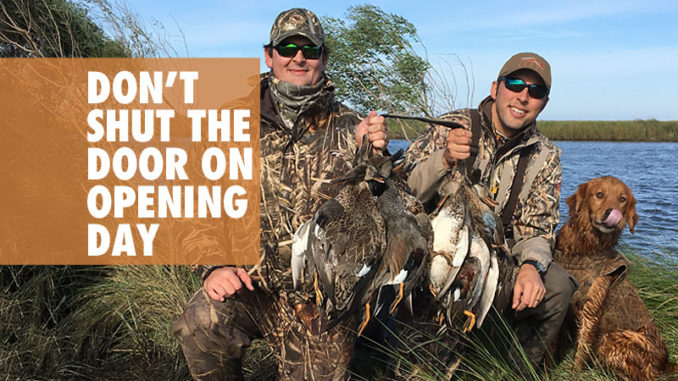
Weed out common hunting mistakes as Louisiana’s duck season finally arrives this month. Here’s how.
Like today’s collection of TV’s zombies, we stumble through the offseason in a near stupor, biding time for our time. Summer mornings spent chasing speckled trout are fine, but all the chatter of “specks this” and “specks that” only bring to mind that first cry of an arriving specklebelly goose that strikes us like no other pursuit can deliver. Even the resident mottleds tease us all summer as we prowl the shallows of the interior marshes for redfish. Their flushing with alarmed quacks brings respite from offseason doldrums with thoughts of fall flights, even if just for a blink.
Indeed, our time is upon us as November kicks off Louisiana’s waterfowl seasons in earnest, and all things that go with them, tangible or otherwise. Given each zone is afforded 60 days, those hunters fortunate enough to hunt multiple zones will be able to extend their seasons.
Smith’s tips
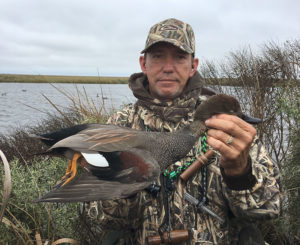
Given so much time elapsed since last season closed in January, one would think that preparations would be wrapped up well in advance of this month’s openers. However, Mike Smith, a long-time guide with Louisiana Marsh Guide Service in the Delacroix area, finds more often than not that hunters show up ill-prepared for opening day success. From shooting woes to ill-fitting clothing, 35 years of guiding has shown Smith that hunters usually aren’t prepared for opening day.
- “More often than not, hunters show up over-choked,” Smith said. “They’ve got long-range, extra-tight chokes, and that leads to shooting challenges when shooting at close range over decoys.” Smith prefers open patterns such as cylinder bore or improved cylinder.
- Smith also said that missteps also show up in shell selections, with hunters armed for bear instead of ducks over decoys. To his point, Smith strictly hunts with a 20-gauge, shunning the larger bore and payload of a 12, finding the 20 is more than sufficient at reasonable ranges.
- Hunters need to be proficient in getting underway when the shot is called.
“Many hunters show up without having practiced with their gun since last season, so they’re slow getting going or want to keep their gun up and mounted, which can flare working birds.”
Barrels sticking up and out of the blind is a cardinal sin when hunting from fixed blinds.
Safety
- Blind safety is paramount, and Smith finds all too often that hunters are not mindful of the safety of their blind partners, nor their hearing.
“I see guys swing over the heads of their buddies all the time. You’ve got to mind your shooting zone, tragic things can happen very quickly,” he said.
- Smith also said that youth hunters can make for dangerous situations as well, due to the short nature of guns cut down for youth size. “Those short barrels don’t lay up in the blind as well as a full-size gun and tend to fall down or get pointed somewhere they shouldn’t,” he said.
- When it comes to decoy placement, Smith avoids defined shapes. “I’ve never seen ducks sitting in a J-pattern,” he said. “However, when targeting divers, I’ll often set a long string downwind, leading to a larger group of decoys and my spinners.”
Keeping decoys largely without a particular shape is far more realistic.
Match what’s there
- Smith believes in matching what he’s seen when scouting, and he emphasizes the use of decoys with plenty of white on them for visibility.
“I don’t own a mallard decoy; I strictly want to match what I’m seeing down this way in St. Bernard Parish, such as gadwall and teal, among others,” he said.
When targeting divers, he likewise matches species just the same. Paying attention to predominant species using a particular habitat goes a long way in replicating their patterns and putting birds in front of guns. Matching gadwall and blue- or green-winged teal decoys to coastal marshes is usually a safe play, while featuring a spread of mallards, pintail and even shovelers brings both realism and visibility to a field spread.
- Set up blinds facing somewhere generally westerly, Smith advises. This will put sun in the eyes of approaching birds during morning hunts. That said, Smith prefers hunting a cross wind when at all possible; that way, approaching birds are focused on the upwind decoys and not the blind.
Dare to be different
Although I find realism via quality decoys of the proper species to be king, there is certainly some strategy to having a different look. At waterfowling’s current demand, more blinds are popping up than ever before, in closer proximity to one another than most would want. It’s simply a matter of demand, and plenty of private-land lessors are happy to oblige for a handsome fee. The same goes for public land where pressure is at least perceived to be as high as ever, particularly given the popularity of ATVs and boats that can go about anywhere.
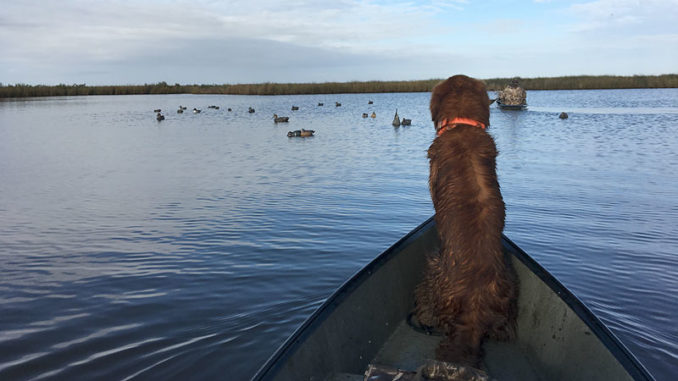
With that in mind, what are you doing to avoid the same stale look to your setup that birds have seen since pointing their beaks southward? Sure, success can be had with the usual cluster of blocks in front of a bushy blind, but after the feathers settle on opening day, it will be the tweaks that you and your hunting party make — or don’t make — that governs longer term success.
Variety in decoys is certainly a place to start, giving consideration for less-traditional species like ringnecks, scaup, shovelers or buffleheads that also offer visibility due to white coloring, and are far less common in front of every bush hiding hunters from Canada to Creole.
Creating motion is a great way to provide a different look.
With rechargeable battery technology better than ever, motion decoys designed to generate splash and ripples can be the difference in committed birds feet down in front or edging off after the proverbial one last pass.
Calling
Much the same can be said for calling. What are you doing to avoid sounding like every other blind the birds have passed since leaving the nest? Call-makers are churning out the latest in high-volume mallard calls, and the average Joe hunter is greeting arriving birds with their best 50-note hail call. This may play well on stage in the offseason, but the blind is the place to sway birds, not judges.
Though the aggressive hail call has its place for high-trafficking birds, subtlety can also be a deadly tool on the lanyard when properly executed. Softer tones and less aggressive cadences will often seal the deal once trafficking birds are turned for a second look. The cliché “less is more” stands true yet again, as we emphasize the quality and variety of our calling in lieu of shouting at them to do as told. Less-traditional plays here would include specialty calls like gadwall, teal, wigeon, pintail or wood ducks, all capable of being a game changer on a given hunt. Learn to run them all in the clutch, and have your blind mates do the same for a cacophony of realism reflective of the decoy species on hand.
Opening day isn’t an excuse to skimp on blind-brushing efforts
Many hunters want to believe that the opening day crowd of birds are nearly “blind” to blinds.
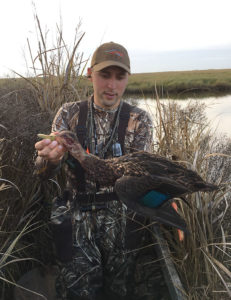
Sure, this is the time of the season where there’s the most room for error, a margin that only tightens as the season progresses. However new the birds might be to your area of The Boot, they’re by no means new to the prospect of guns hiding in the bushes. With so much effort put into decoys, clothing and other necessities, don’t let a sub-par blind-brushing derail your odds for opening day success.
- Utilize as much native material as possible for brushing, be it a rice field levee or marsh pond. Field-area grasses are ideal for hiding a pit, just as local bushes and tall grasses are the go-to’s for hiding a marsh blind.
- Ensure cover from all angles is sufficient, including over the top. Too many focus on how they look from the sides and fail to consider that the birds also fly over the top, looking down.
- Minimize trampling of habitat immediately around the blind; the best blinds often have a single path for entering and leaving.
- Be aware of early season critters that may be present in and around your blinds, from snakes to spiders or even alligators.
- The opening day brush job will soon deteriorate with weathering; be sure to refresh regularly. Packing along a little brushing material each hunt isn’t a bad habit to get into.
Opening day gear guide
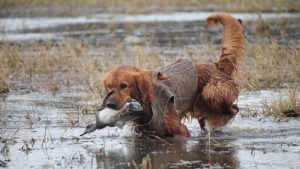
We all have our favorites, as well as particular items we might use out of nostalgia, but the following should always make the packing list for opening day this month:
- 2¾- and 3-inch shells in non-toxic shot sizes from No. 2 to No. 4 for ducks, BB to No. 2 for geese
- Choke tubes from improved cylinder to modified
- Head lamp
- Mosquito spray and/or Thermacell
- Call lanyard
- Ear protection
- Game tote or strap
- Face mask
- Hats for rain and/or sunny conditions
- Outer wear like jackets good for rainy conditions, preferably breathable material
- Long-sleeve shirt to be worn on mild hunts
- Lightweight and heavyweight gloves
- Knee boots, chest or hip waders
- All required state licenses plus federal duck stamp
- All supplies needed for your retriever: food, bowls, etc.